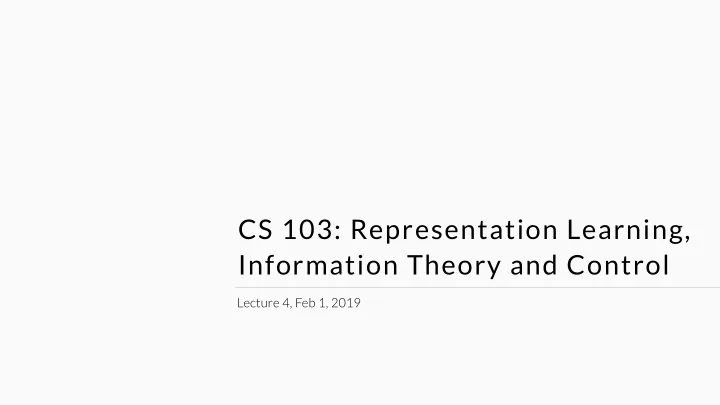

CS 103: Representation Learning, Information Theory and Control Lecture 4, Feb 1, 2019
Seen last time 1. What is a nuisance for a task? 2. Invariance, equivariance, canonization 3. A linear transformation is group equivariant if and only if it is a group convolution • Building equivariant representations for translations, sets and graphs 4. Image canonization with equivariant reference frame detector • Applications to multi-object detection 5. Accurate reference frame detection: the SIFT descriptor • A sufficient statistic for visual inertial systems 2
Where are we now Cognition Sensing Action Invariance to simple geometric nuisances, corner detectors, … 3
Where are we now Invariance to complex nuisances, classification, detection, … Cognition Sensing Action 4
Compression without loss of *useful* information Task Y = Is this the picture of a dog? Original X Compressed Z X ~ 350KB Z ~ 5KB Z is as useful as X to answer the question Y , but it is much smaller. Image source https://en.wikipedia.org/wiki/File:Terrier_mixed-breed_dog.jpg 5
Compression without loss of *useful* information Task Y = Is this the picture of a dog? Z is as useful as X to answer the question Y , but it is much smaller. Image source https://en.wikipedia.org/wiki/File:Terrier_mixed-breed_dog.jpg 6
The “classic” Information Bottleneck
Some notation Cross-entropy: The standard loss function in machine learning H q,p ( x ) = E x ∼ q ( x ) [ − log p ( x )] Kullback-Leibler divergence: “Distance” between two distribution (used in variational inference) log q ( z ) h i KL( q ( z ) k p ( z )) = E z ∼ q ( z ) p ( z ) = H q,p ( x ) � H q ( x ) Mutual Information: Expected divergence between the posterior p(z|x) and the prior p(z). I ( x ; z ) = E x ∼ p ( x ) [KL( p ( z | x ) k p ( z ))] = H p ( z ) � H p ( z | x ) 8
The Information Bottleneck Lagrangian Tishby et al., 1999 Given data x and a task y , find a representation z that is useful and compressed . minimize p ( z | x ) I ( x ; z ) H ( y | z ) = H ( y | x ) s.t. Consider the corresponding Lagrangian (the Information Bottleneck Lagrangian) L = H p,q ( y | z ) + β I ( z ; x ) Trade-off between accuracy and compression governed by parameter β . 9
Compression in practice Increase dimension + Reduce the dimension Inject noise in the map x 1 z 1 x 1 z 1 x 2 z 2 x 2 z 3 x 3 x 3 z 2 X4 z 4 X4 Z X X Z Examples: max-pooling, dimensionality reduction Examples: Dropout, batch-normalization 10
Application to Clustering An important application is task-based clustering, or summaries extraction. Terrier Dog Bird Dog Owl Terrier Beagle Owl Bird Beagle Parrot Parrot Z X See also Deterministic Information Bottleneck for hard-clustering vs soft-clustering. Strouse and Schwab, The Deterministic Information Bottleneck, 2016 11
• We can reuse the classic theory (including Blahut-Arimoto, next slide) Information Bottleneck and Rate-Distortion Rate-Distortion theory: What is the least distortion D obtainable with a given capacity R ? min E x,z [ d ( x, z )] p ( z | x ) I ( z ; x ) ≤ R s.t Equivalent to IB when d(x, z) is the information that z retains about y : d ( x, z ) = KL ( p ( y | x ) k p ( y | z )) Rate-distortion/IB curve: 12
Blahut-Arimoto algorithm Blahut, 1972; Arimoto, 1972; Tishby et al., 1999 In general, no closed form solution. But we have the following iterative algorithm: Encoder p(z|x) Decoder p(y|z) p t ( z ) p t ( z | x ) ← Z t ( x, β ) exp( − 1 / β d ( x, z )) X p t +1 ( z ) ← p ( x ) p t ( z | x ) x … X p t +1 ( y | z ) ← p ( y | x ) p t ( x | z ) y But what happens if p(z|x) is too large, or parametrized in a non-convex way? 13
Recommend
More recommend